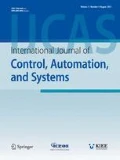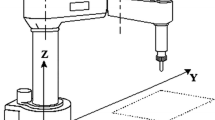Abstract
This article presents a neural network control technique to improve the tracking performance of a robot manipulator controlled by the sliding mode control method in a non-model-based framework. The sliding mode controller is a typical nonlinear controller that has been well developed in theory and used in many applications due to its simplicity and practicality. Selection of the gain of the nonlinear function plays an important role in performance as well as stability. When the sliding mode controller is used for the non model-based configuration in robot control, the nonlinear gain should be selected large enough to guarantee the stability. Since the appropriate selection of the gain value is essential and difficult in the sliding mode control framework, a neural network compensator is introduced at the trajectory level to help the fixed gain deal with the stability and performance more intelligently. Stability of the proposed control scheme is analyzed. Simulation studies of following the Cartesian trajectory for a three-link rotary robot manipulator are conducted to confirm the control improvement by the neural network.
Similar content being viewed by others
References
E. Sariyildiz and K. Ohnishi, “On the explicit robust force control via disturbance observer,” IEEE Trans. Industrial Electronics, vol. 62, no. 3, pp. 1581–1589, 2015. [click]
K. Kong and M. Tomizuka, “Nominal model manipulation for enhancement of stability robustness for disturbance observer-based systems,” International Journal of Control, Automation, and Systems, vol. 11, no. 1, pp. 12–20, 2013.
S. D. Lee and S. Jung, “Analysis of time constant effect in the Q filter for designing a disturbance observer: balancing control of a single-wheel robot,” Journal of The Institute of Electronics and Information Engineers, vol. 53, no. 10, pp. 1711-171, 2016.
W. Gao and Z. P. Jiang, “Adaptive dynamic programming and adaptive optimal output regulation of linear system,” IEEE Trans. on Automatic Control, vol. 61, no. 12, pp. 4164–4169, 2016. [click]
W. Gao and Z. P. Jiang, “Nonlinear and adaptive suboptimal control of connected vehicles: A global adaptive dynamic programming approach,” Journal of Intelligent & Robotic Systems, vol. 85, no. 3-4, pp. 597–611, 2017. [click]
H. Gomi and M. Kawato, “Learning control for a closed loop system using feedback error learning,” Proc. of the IEEE International Conf. on Decision and Control, pp. 3289–3294, 1990.
R. J. Wai and R. Muthusamy, “Fuzzy-neural network inherited sliding-mode control for robot manipulator including actuator dynamics,” IEEE Trans. on Neural Network and Learning Systems, vol. 24, no. 2, pp. 274–287, 2013. [click]
H. Xin and Q. Chen, “Full-order neural sliding model control of robotic manipulator with unknown dead-zone,” Proc. of Chinese Automation Conference, pp. 1664–1669, 2015.
F. L. Lewis, S. Jagannathan, and A. Yesildirek, Neural Network Control of Robot Manipulators and Nonlinear Systems, Taylor & Francis, 1999.
R. G. Rodriguez and V. P. Vega, “Tracking control of robot manipulators using second order neuro sliding mode,” Latin American Applied Research, vol. 39, no. 4, pp. 285–294, 2009.
H. Zhang, M. Du, and W. Bu, “Sliding mode controller with RBF neural network for manipulator trajectory tracking,” IAENG International Journal of Applied Mathematics, vol. 45, no. 4, 2015.
T. Liu and S. Yin, “An improved neural network adaptive sliding mode control used in robot trajectory tracking control,” International Journal of Innovative Computing, Information and Control, vol. 11, no. 5, pp. 1655–1666, 2015.
S. Jung and T. C. Hsia, “Neural network inverse control techniques for PDcontrolled robot manipulator,” Robotica, vol. 19, no. 3, pp. 305–314, 2000.
S. Jung, “Stability analysis of reference compensation technique for controlling robot manipulators by neural network,” International Journal of Control, Automation, and Systems, vol. 15, no. 2, pp. 952–958, 2017. [click]
Author information
Authors and Affiliations
Corresponding author
Additional information
Recommended by Associate Editor Kang-Hyun Jo under the direction of Editor Euntai Kim. This work has been supported by the basic research funds through the contract of National Research Foundation of Korea (2016R1A2B2012031).
Rights and permissions
About this article
Cite this article
Jung, S. Improvement of Tracking Control of a Sliding Mode Controller for Robot Manipulators by a Neural Network. Int. J. Control Autom. Syst. 16, 937–943 (2018). https://doi.org/10.1007/s12555-017-0186-z
Received:
Revised:
Accepted:
Published:
Issue Date:
DOI: https://doi.org/10.1007/s12555-017-0186-z




